Over the centuries predator birds perceived man mystical, endowed with special forces creatures. In various tribal cultures there were religious movements dedicated to predatory killers, they became patrons of the warrior and shaman caste. In modern ornithology, the term "bird of prey" refers to any species of birds that have strong claws, sharp eyesight and a strong, curved beak. Theoretically, the largest representatives of this species could well kill even a man.
1. Bearded tawny.
The bearded owl is rightfully considered to be the largest bird in the world from the order of owls. The length of the bird’s body reaches 80 cm, the wingspan is 1.5 m. During the day, it hunts mainly for small rodents, sometimes for squirrels. The habitat of the bird is rather wide: the bearded owl prefers the taiga zones and is found in the territories from Siberia to Transbaikalia.
2. Andean Condor
The Andean condor is the largest flying bird in the Western Hemisphere; Despite the fact that its length from beak to tail is on average 5 cm shorter than that of the California Condor, it is much larger than its nearest relative in wingspan (274-310 cm). In addition, it is heavier - the weight of males reaches 11-15 kg, females - 7.5-11 kg. The length of adult birds varies from 117 to 135 cm. The ration of the Andean condor consists of carcasses of dead animals, carrion. In search of food, birds often travel long distances, flying up to 200 km per day. Away from the sea, they prefer the remains of large ungulates, such as deer, guanacos, cows killed by natural death, or strangled with puma. On the seashore they feed on carcasses of marine mammals cast ashore. In addition to carrion, they also destroy the nests of colonial birds, feeding on their eggs and attacking chicks. It is found in the Andes and on the Pacific coast of South America. Condors live up to seventy years, however the population of these birds is under threat.
3. Martial Eagle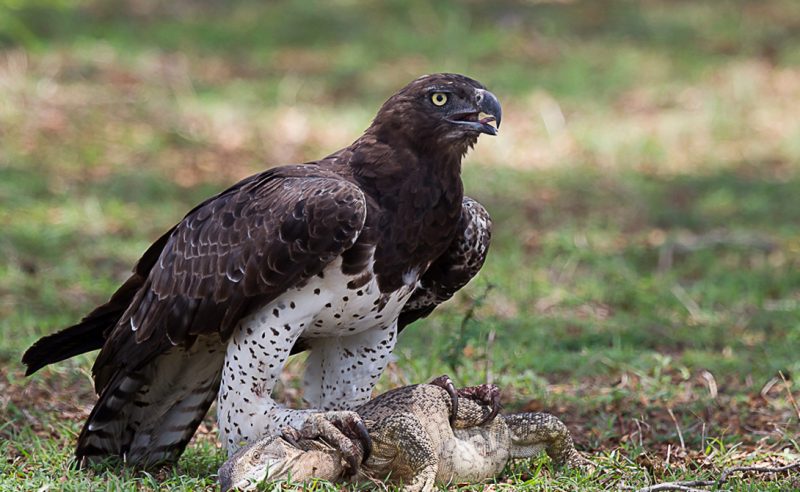
Martial eagles are found primarily in the open areas of sub-Saharan Africa. Females are somewhat larger and heavier than males, the size of which averages only 75% of the size of females. Body length from 78 to 96 cm, wingspan from 188 to 227 cm.
Couples of fighting eagles own ranges of more than 1000 km². Couples nest at a distance of about 50 km from each other, which is the lowest density of settlement among all the birds in the world.
4. Philippine Eagle
The monkey eagle is considered one of the rarest, largest and most powerful birds in the world. The Philippine harpy reaches a length of 80-100 cm, wingspan up to 220 cm. Females weighing from 5 to 8 kg, slightly larger than males, weighing from 4 to 6 kg. You can meet him only in the tropical forests of the Philippines: here he is considered the national symbol of the country. Killing this endangered bird is punishable by the laws of the Philippines with twelve years in prison and a large fine.
5. Snow neck
One of the largest griffons of the world lives in the high regions of the Himalayas, the Pamirs and Kazakhstan. Weight 8-12 kg, length 116-150 cm, wingspan up to 310 cm. Makes vertical seasonal migrations, descending lower in winter. It feeds on carrion, mainly ungulates. A few nesting sites of the snow neck are found on the Tibetan plateau. Hunting for this species is prohibited by local law, but for poachers catching such a vulture means huge profits, and the bird population is steadily decreasing.
6. South American Harpy
This large hawk is found in the plains and rainforests of South America. The length of the body of this hawk is from 90 to 110 cm. The wingspan is about 2 meters. The female weighs 6–9 kg, the smaller male 4–4.8 kg. Harpy hunts large mammals such as sloths and monkeys. Harpies are the only predators, with the exception of smooth-faced Caimans, hunting tree (or tentacle) porcupines Unfortunately, deforestation in harpy nesting places leads to a steady decline in the population of these dangerous and beautiful birds: there are now less than 50,000 individuals.
7. Bearded
The "bearded man" is named for a bundle of rigid feathers or setae under the beak, forming a beard. Distributed in Southern Europe, Eastern and Southern Africa, Front and Central Asia. The bearded man was successfully reintroduced in the Alps, but still remains the rarest bird of prey in Europe.
It feeds mainly on carrion, sometimes turtles and rodents. Life expectancy in captivity up to 40 years.
8. wandering albatross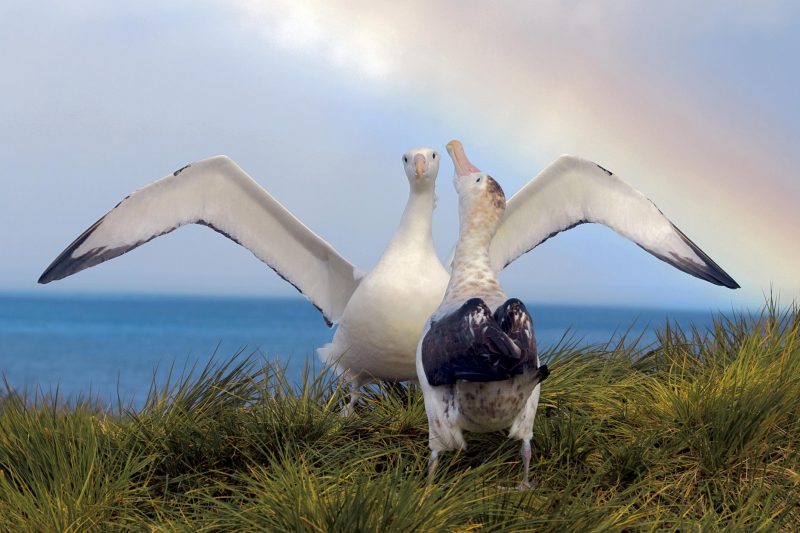
Wandering albatrosses reach a length of up to 117 cm and have the largest wingspan among modern birds - up to 325 cm. Wavy albatrosses are also called wandering. Albatross is a single bird, but it nests in colonies. In general, the bird does not fly above 15 m above the water. Albatross can fly against the wind. An albatross can fly up to 1000 km per day. The average life expectancy is 10-30 years, but in some cases it can reach 50 years. Albatros are fed most often at night. Its diet consists of fish, mollusks and crustaceans, as well as garbage left behind by trawlers and floating bases for processing fish and seafood.
9. Golden Eagle
The most famous and most common bird of prey in the entire northern hemisphere, where it lives mainly in the mountains, to a lesser extent in the flat open and semi-open landscapes. The wingspan of the golden eagle reaches an impressive 2.34 meters - a real killer machine. Since ancient times, the bird is considered the patron saint of hunters and has a great mystical influence in many tribal cultures. To date, the golden eagle has completely disappeared or has become a very rare bird in many regions of the world, more or less remaining only in the mountains, treeless tundra and steppes. According to environmentalists, the total number of birds in the world today is about 170 thousand individuals, of which only 6.5 to 7.5 thousand are in Europe.
10. Hawk Eagle
The largest bird in South Africa is most commonly found south of the Sahara. Hawk Eagle is armed with huge, razor-sharp claws, and the blow of its hind legs is so strong that it could even knock a human. These birds do not feed on carrion and do not dig the burial grounds of fallen food; they would rather prefer small insects or lizards, frogs. A monkey lover hawk eagle, if a female dies, the male will never again start a new family, most often in the end he dies himself.
Birds that hunt animals, primarily through flight and air attack, use their senses, especially eyesight. They are defined as predator birds, first of all, they hunt vertebrates, including other birds. Their claws and beak, as a rule, are relatively large, powerful and adapted to tearing flesh. In most cases, females are much larger than males. The term “raptor” is derived from the Latin word rapere (meaning seizing or taking by force), and may refer informally to all such hunters, or specifically to diurnal groups. Because their predatory lifestyle, is often found at the top of the food chain they encounter. Many species birds of prey may be semi predatory or completely predatory. However, in ornithology, the term “bird of prey” is used only for the feathered families listed below.
Definition
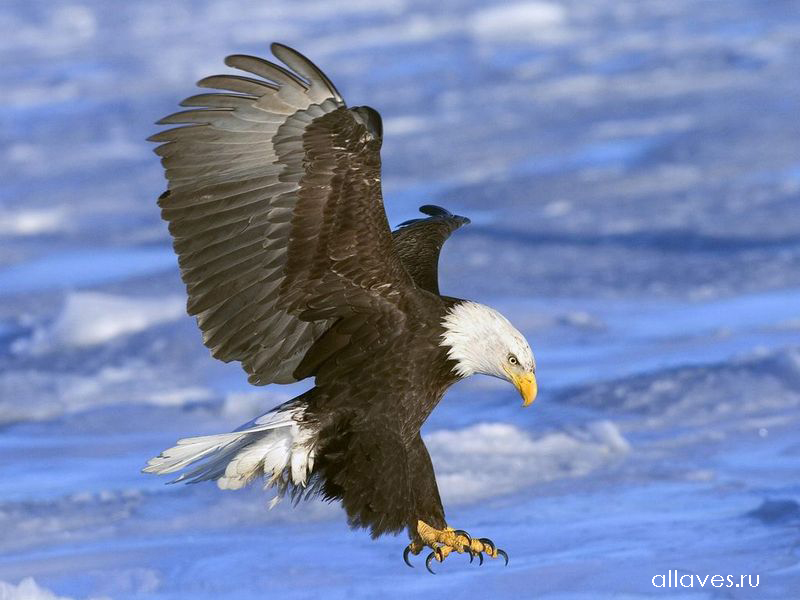
Strictly speaking, the term " predatory bird"Has a broad meaning, which includes many birds, hunting and feeding on animals, as well as birds, which feed on very small insects. In ornithology, there is a definition that is used here, this term has a narrower meaning for hunting birdswhich have very good eyesight for searching for food, strong legs with sharp claws to catch food, and a strong strong curved beak for tearing the flesh. Most carnivorous birdsThey also have strong, curved claws to catch or kill the victim. Predator birdstend to prey on vertebrates, which are usually quite high relative big size the birds themselves. Most also eat carrion, at least sometimes. Vultures and condors feed on carrion; this is their main source of food. As an example, the narrower definition excludes the gulls of their birds of prey, which catch and eat rather large fish, partly because these birds of prey catch and kill prey entirely with their beaks, and like the birds of the skuas, feed on fish and vertebrates. Using this cluster, the morphological and behavioral characteristics of the species listed below are usually for carnivorous birds in ornithology. They can be divided into species that hunt during the day, and those that hunt at night, for example. Birds of prey and owls distantly related and classified into separate families, however, their evolution was convergent, both groups of birds adapted to a predatory way of life.
Classification history.

Systematics of Carl Linnaeus, grouped birds (class Aves) into orders, families and species, without formal series between genera and orders. He put everyone birds of prey in one order, subdivided into four genus: Vultur (vultures), Falco (eagles, hawks, falcons, etc.), Strix (owls), and Lanius (shrikes). This approach was then used by subsequent authors, such as Gmelin, Albany, and Turnton.
Classification, division into day and night predators.
Day birds of prey, formally divided into five families (the traditional classification of the family, at present):
Accipitridae: hawks, eagles, buzzards, vultures;
Pandionidae: Osprey (sometimes classified as a subfamily Pandioninae of the previous family);
Sagittariidae: bird secretary;
Falconidae: falcons, caracaras;
Cathartidae: necks including condors.
Nocturnal birds of prey, include such representatives as - owls - are classified separately, as members of two families that have come down to us, the family:
Strigidae: typical owls;
Tytonidae: barn owl.
Observations show that otherwise unrelated groups of birds can perform similar ecological functions and contain many morphological similarities with each other, due to the concept of convergent evolution.
Common Names.
Common names for various birds of prey are determined on the basis of structure, but many traditional names do not reflect the evolutionary relationship between groups.
Falco rusticolus (gyrfalcon). The largest representative of falcons in the world, the so-called "ghostly" Krechet, who received his nickname for a specific "smoky" color, is one of the most brutal birds of prey in the upper latitudes of the Arctic.
Accipiter striatus. The smallest of hawks in North America. At the same time he is the most audacious and agile acrobat in the air. They have distinctive proportions: long legs, short wings, and very long tails, which they use for maneuvering while hunting in dense groves, in pursuit of birds and mice at breakneck speed.
- variable size, usually nocturnal birds of prey - specialized hunters. They fly almost silently thanks to the special feather structures that reduce turbulence. They have a particularly keen ear.

- is one of the largest, fastest and agile birds among eagles in particular, and birds of prey in general. Brilliant golden feathers adorn the back of the head and neck; powerful beak and claws demonstrates its hunting prowess.
- As a rule, large birds of prey with long, wide wings, powerful beak and massive legs, also have plumage on their legs. Build very large nests.
- The bird of prey of the same species, found all over the world, specializes in fishing and has adapted for this paws bent claws. Build large nests, the diameter of which can reach 2 meters.
- have long wings and relatively weak legs. They spend a significant portion of their time in flight. They catch live vertebrate prey, but mostly feed on snakes.
- medium and large birds of prey with robust senses and wide wings include members of the genus hawks (also known as “Buteo” in North America).
- big as hawks predator birdswith long tails and long thin legs. Most use a combination of keen sight and hearing to hunt small vertebrates, gliding on their long wide wings and spinning low over meadows and marshes.
— predatory bird, scavengers, are divided into two different biological families: Hawks, which is found only in the Eastern Hemisphere, and American Vultures, which is found only in the Western Hemisphere. Members of both groups have heads partially or completely devoid of feathers.
Falconry, birds of prey video
Martial Eagle - the largest eagle in Africa, has a wingspan of up to 2.6 meters and reaches weights up to 6.2 kg. Very aggressive predator, eats everything that can catch (other birds, baboons, lion cubs, and even antelopes). Unfortunately, martial eagles occasionally attack lambs and young sheep because of this, local farmers consider them pests. It is for this reason that they are shot and poisoned. Today, this magnificent bird in nature is very rare.

The Shoulder Eagle (a relative of the famous American Bald Eagle) lives in Russia and Japan. It feeds mainly on fish, but sometimes attacks other large birds, such as cranes and swans. This is the heaviest eagle, as well as one of the most dangerous birds in the world, weighing up to 9 kg, and a wingspan of almost 2.5 meters. Compared to other eagles, the Steller’s sea eagle has the most powerful and largest beak. Unfortunately, this bird is endangered.

A striped fish owl is the largest owl in the world. It lives in Siberia and Japan. This magnificent bird has a wingspan of 2 meters and weighs up to 4.5 kg. It feeds (you guessed it) mostly fish.
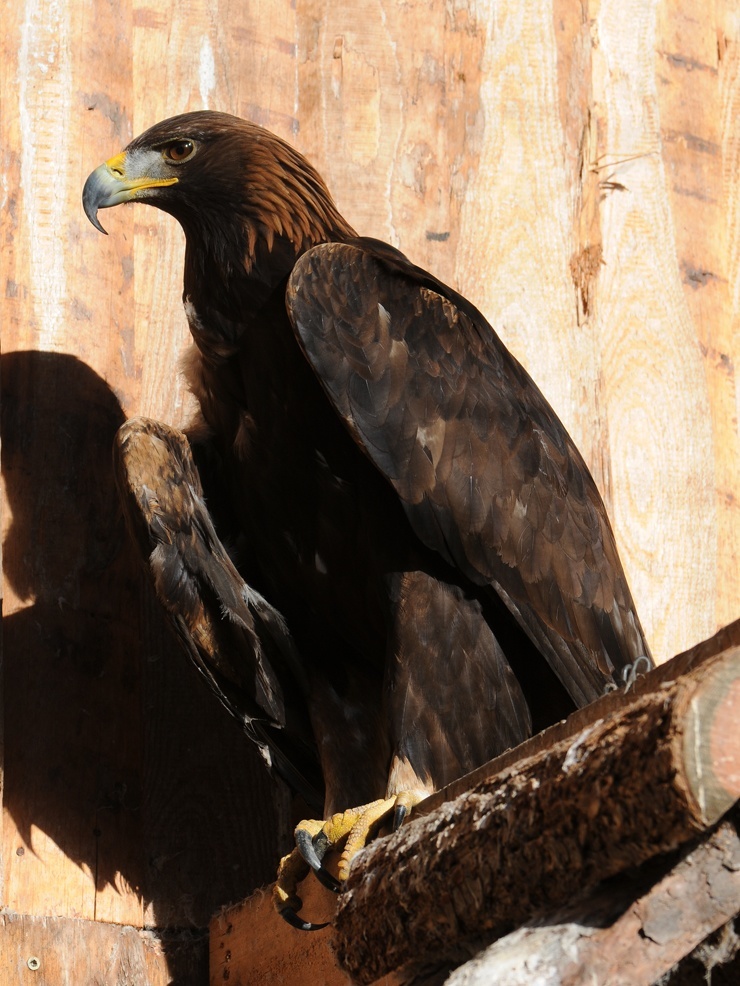
It lives in North America, Eurasia and North Africa. It is one of the most formidable aerial predators, as well as one of. They feed mainly on rabbits, hares and large birds; prey on other birds of prey. Despite the fact that the golden eagle is a powerful enough bird that can kill a person, it never attacked people. A golden eagle can weigh up to 7 kg and has a wingspan of 2 meters. Females are larger and more aggressive than males. The fossils found in Europe suggest that in prehistoric times, several thousand years ago, they were even larger.

The Philippine eagle is one of several large eagles adapted for hunting in wooded places. This magnificent view lives exclusively in the Philippines, where it is a national symbol. It can weigh up to 7 kg, has a 2-meter wingspan. It feeds mainly on monkeys, flying lemurs, big bats, and even pigs and dogs. The Philippine Eagle is protected by law. For killing this bird you face twelve years in prison. However, despite this punishment, the Philippine eagle is considered an endangered species, today there are only 200-400 individuals in the wild.
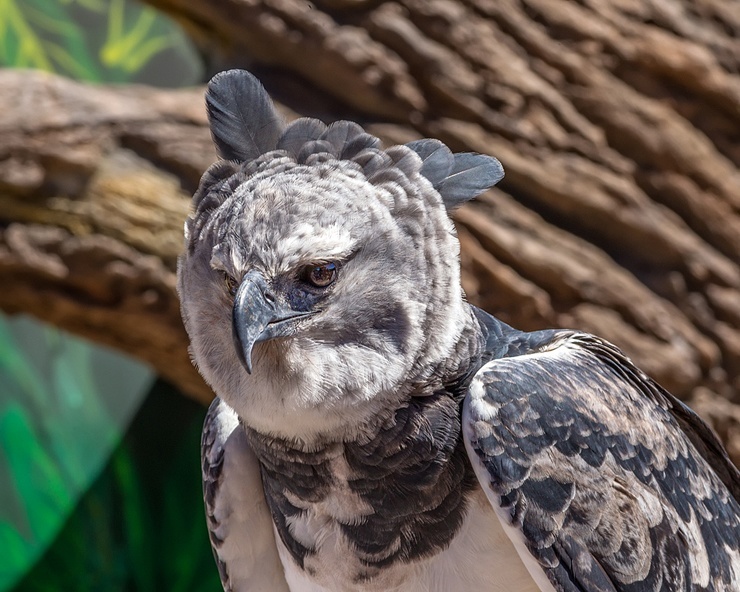
The South American harpy is often called the strongest eagle in the world. Its mass can reach up to 9 kilograms. The claws of this bird are longer than the claws of a bear; it can easily break a person’s limb or even pierce a skull if he wants to. Fortunately, the harpies never attacked people (if they do not protect their nest). They feed mainly on monkeys, sloths, and large birds such as parrots. On the occasion also iguanas and boas. Currently, the number of these large South American eagles is constantly decreasing. The main factor in this is the destruction of forests in the harpy nesting areas, as well as the distinctive features of breeding - the pair grows only the 1st chick. In certain places in Mexico, they are so rare that the locals consider them semi-legendary birds.
bearded bird (Lamb)

The ovum lives in Europe, Asia and Africa. It can weigh up to 8 kg, and its wingspan reaches over 3 meters. Bearded men generally feed on carrion, largely bones, which they chop, throwing them from a height (if necessary several times) on rocks or stones. Catch turtles, which breaks the same way.

The American Long-eared Vulture is one of the largest vultures. The length of the body reaches 115 cm, the wingspan is up to 3 meters, and the weight of this bird is 10–14 kg. It lives in North Africa and is distributed from the Atlantic Ocean to the Red Sea, as well as on the Arabian Peninsula, to the south - along the Indian Ocean to the end of South Africa. It feeds mainly on carrion, but it was known that these birds kill young gazelles and antelopes, and also hunt colonies of flamingos. He steals eggs and chicks, from other birds. Very aggressive. Even the cheetah prefers to stay away from this vulture's dangerous beak.
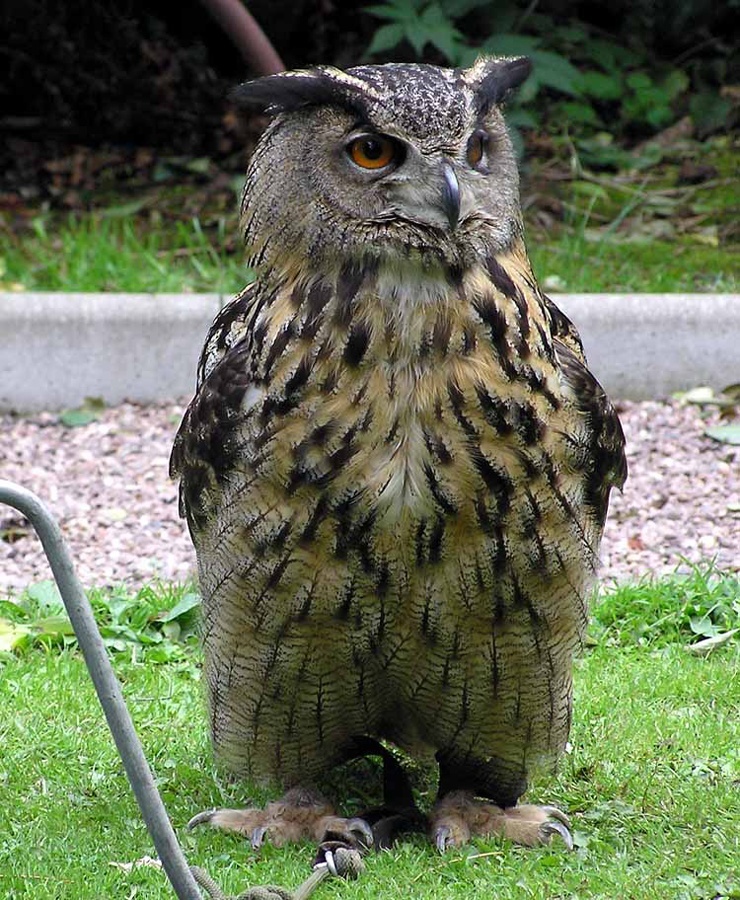
The Eurasian eagle owl lives in the forests and mountains of Asia and Europe. Weighing up to 4.3 kg, with a wingspan of up to 2 meters. These owls are among the largest and most powerful birds, and although they feed mostly on rodents, rabbits and hares are also well known for killing and eating other birds of prey, both day and night (including some eagles).

Crowned eagle lives in tropical forests of Africa. Reach approximately 90 cm. In length, wingspan up to 2 meters. As is known, animals that weigh up to 35 kg are hunted. This powerful and aggressive eagle is known among Africans as the “air leopard”. His main weapons are deadly claws that are strong enough to crush a monkey's skull (his favorite prey). In prehistoric times, these eagles hunted our ancestors Australopithecus. Even in our time, the Crowned Eagle regards man as a potential prey. He is considered the most dangerous bird in the world.
In Zambia, a seven-year-old boy on the way to school was attacked by a crowned eagle and received serious injuries to his head, chest and arms, a predator unsuccessfully trying to carry him away, until a woman arrived to the rescue who heard the boy's cries. Later, after researching the area, the scientists did not find the eagle's nest. In addition, the eagle turned out to be “underage”, this fact means that he did not defend his nest, but attacked in order to eat.
Share in social. networks
The list includes species such as day and night. By the day include the hawk, falcon and other units. mainly represent owls and barn owls. They can be of the most various size, have as huge scope (the American condor), and the tiniest wings which, for example, the dwarf falcon has. Hawks, vultures, kites, condors, owls, owls - they are all on the list of birds of prey. These species of birds live around the world, they are not only in the Antarctic, as well as on some ocean islands. The eagle and the golden eagle are also birds of prey. The list continues with various species of falcons. It is impossible not to admire the magnificent flight and the circling above the earth of these magnificent birds. Besides them, it is included in the list of predatory or, as it is also called, bucket.
Features of existence
These amazing creatures have a rather long life. Many of them have been living for more than fifty years, in the history of ornithology there have been cases when eagles, hawks and other species kept in captivity from 45 to 69 years. In nature, the life of birds is much shorter, on average it is between fifteen and twenty five years. Birds of prey breed only once a year, in very rare cases, two. Before laying eggs, a couple builds a nest for future chicks, they can also live in a strange and already prepared place. Mostly such birds choose tall trees and rocks for nests, but sometimes they nest on the ground. Hatching eggs is usually the female, it occurs within two months, each species is different. Sometimes the male replaces her in this work, but not for a long time. Nestlings are born quite strong and strong, most of them are already sighted. 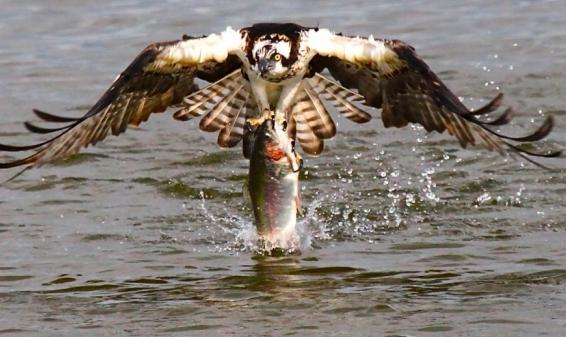 Nestlings of small birds of prey grow very quickly and fly out of the nest, but for such as necks, it takes several months for them to grow up and be able to fly. These predator species feed mainly on animals, including various mammals, insects and small birds. Also often predatory individuals feed on carrion, and very little - on vegetation.
Nestlings of small birds of prey grow very quickly and fly out of the nest, but for such as necks, it takes several months for them to grow up and be able to fly. These predator species feed mainly on animals, including various mammals, insects and small birds. Also often predatory individuals feed on carrion, and very little - on vegetation.
Russian birds of prey
The country is home to many species of various birds of prey. These are mainly eagles and eagles, hawks, kites, as well as a list of birds of prey of Russia, supplemented by various specimens of owls, owls, and golden eagles.  Each band is characterized by its own species. In the forests and fields - these are one specimens, and in the highlands — others. Every bird species adapts to a specific habitat and climatic conditions. Osprey, otkoyedy, luni, buzzards are also all birds of prey of Russia. Photos of such powerful and powerful birds show all the magnificence of nature that created them.
Each band is characterized by its own species. In the forests and fields - these are one specimens, and in the highlands — others. Every bird species adapts to a specific habitat and climatic conditions. Osprey, otkoyedy, luni, buzzards are also all birds of prey of Russia. Photos of such powerful and powerful birds show all the magnificence of nature that created them.
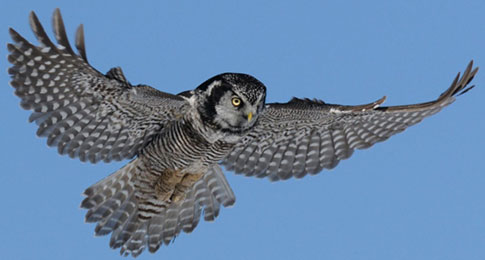
Most diurnal birds of prey are classified as Falconiformes (Falconiformes):
Nocturnal birds of prey are represented by representatives of the order of owls (Strigiformes), which include two families:
About 270 species belong to this order. These are birds of medium and large size. In one of the largest species - the American condor - the wing is about 115 cm long, its wingspan is up to 275 cm. The smallest birds of prey - the so-called dwarf falcon - have a wing length of 9-10 cm.
The birds of prey are characterized by a strong hook-like beak curved at the end, the base of which is covered with bare, brightly colored skin - a glove, into which the external openings of the nostrils open. Legs of birds of prey of moderate length, with curved and usually sharp claws (only secretaries have long legs). Claws and beak are used to kill, and the latter and for the dismemberment of prey. The fingers are relatively long; there are pads on the plantar side to hold the prey. The constitution is dense, the plumage is rigid and tight to the body. The color is usually dull, mostly gray, brown, red or black, often with an admixture of white. In some carrion-fed species, the head and part of the neck are bare, non-feathered.
There are 10 primary primary feathers, the number of secondary primary feathers is different, most often 12, but in some well-hovering large species (for example, in the vultures) 19-20. The tail is usually short (the exception is the secretary), rounded or carved on the top, of 12 tail feathers (in some large species of 14). In most species, males and females are similarly colored, but young birds differ from adults in coloring in the first year, and sometimes later. Usually males are smaller than females, but at the vultures of the Old World both sexes are the same size, and in American condors males are larger than females.
Birds of prey are diurnal, only a few of them are twilight. Birds of prey are spread all over the world: they are not found only in the Antarctic and on some oceanic islands.
In the northern and temperate latitudes of the species of flight, part of the settled and wanders outside the breeding time.
Life expectancy of birds of prey is quite significant. There are cases when the eagle-buffoon lived in captivity for 55 years, the eagle-golden eagle - 46 years, in the Moscow zoo the condor lived for 69 years, the hawk-goshawk - 25 years. Ringing data also shows that medium-sized birds of prey live for at least about 15 years. Hardly all this deadlines.
The birds of prey are monogamous. Spread once (rarely twice) per year. The nests of a simple device, usually on trees, sometimes in hollows, on rocks, on the ground. Often engaged in the finished nest, built by another species of birds. Usually the same pair nests from year to year in the same nesting area. The number of eggs varies from 1–2 (in large species) to 6–7 and even 9 (in small ones).
Hatching begins after laying the first egg, and the chicks in the brood are therefore of different ages. The female mainly incubates, the male replaces it only for a short time. Large species hatch almost 2 months (for example, condor, bearded). Species of average size incubate for about a month. Chicks out of the eggs well-pubescent and sighted, but during their stay in the nest need feeding and heating, as well as protection from enemies. Departure from the nest in small and medium species of predators occurs at about a month of age, for large vultures - only at three - and even four months.
The main food of birds of prey is made up of various animals, primarily mammals, birds and insects. Often, birds of prey feed on carrion. Few of them eat plant foods. Some species feed on a wide range of feeds, others are highly specialized.
Under natural conditions, birds of prey eat prey with bones, wool, feathers, the undigested remains of which are periodically discarded through the mouth in the form of so-called pogadki.